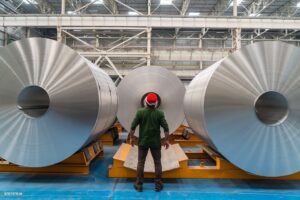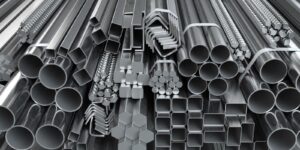
In 2024, Ukrainian metallurgical enterprises increased their production of total rolled products by 15.8% year-on-year to 6.222 million tons from 5.372 million tons, according to preliminary data.
According to Ukrmetallurgprom, steel production increased by 21.6% to 7.575 million tons and pig iron by 18.1% to 7.090 million tons during the period.
In December, the company produced 480.8 thousand tons of rolled products, 547 thousand tons of steel, and 565.4 thousand tons of pig iron, compared to 477 thousand tons of rolled products, 540.8 thousand tons of steel, and 542.9 thousand tons of pig iron in the previous month.
As reported, in 2023, Ukraine increased production of total rolled products by 0.4% compared to 2022 to 5.372 million tons, but reduced steel production by 0.6% to 6.228 million tons, and pig iron by 6.1% to 6.003 million tons.
In 2022, Ukraine reduced production of total rolled products by 72% compared to 2021, to 5.350 million tons, steel by 70.7% to 6.263 million tons, and pig iron by 69.8% to 6.391 million tons.
In 2021, the company produced 21.165 million tons of pig iron (103.6% compared to 2020), 21.366 million tons of steel (103.6%), and 19.079 million tons of rolled products (103.5%).

Zaporizhzhia Iron and Steel Works “Zaporizhstal” increased its rolled steel output by 18.1% in 2024 compared to 2023, up to 2 million 426.7 thousand tons from 2 million 54.7 thousand tons.
According to the company’s press release on Thursday, steel production for the period increased by 17.2% to 2 million 890.8 thousand tons, and pig iron by 14.2% to 3 million 106.3 thousand tons.
In December, Zaporizhstal produced 284.7 thousand tons of iron, 245.5 thousand tons of steel, and shipped 234.1 thousand tons of rolled products.
Taras Shevchenko, Acting CEO of Zaporizhstal, stated that in 2024, the plant continued to operate in the face of the proximity of the frontline and the resulting security risks, a significant shortage of personnel due to mobilization and migration, significant energy supply restrictions, the crisis in global markets and stagnation of the domestic steel market, etc.
“It took a lot of effort to keep the plant’s production capacity utilization at an average of 75% and, in addition, to continue support programs for the team, the region and the army. The key focus of Zaporizhstal’s team in 2024 was on finding solutions to improve our own sustainability, efficiency and competitiveness – and, given the disappointing forecasts for 2025, we will continue this work to save the plant and our team,” Shevchenko said.
The press release clarifies that the increase in production in 2024 compared to 2023 is due to higher blast furnace productivity, increased demand for commercial pig iron and the partial restoration of the sea freight export route.
In 2023, the plant operated at an average of 70% of its capacity.
As reported, in 2023, Zaporizhstal increased its rolled products output by 57.2% compared to 2022, up to 2 million 54.7 thousand tons, steel by 65.4%, up to 2 million 466.9 thousand tons, and pig iron by 35.3%, up to 2 million 718.9 thousand tons.
“Zaporizhstal is one of the largest industrial enterprises in Ukraine, whose products are in great demand among consumers both in the domestic market and in many countries of the world.
“Zaporizhstal is in the process of integration into Metinvest Group, whose major shareholders are System Capital Management (71.24%) and Smart Holding Group (23.76%).
Metinvest Holding LLC is the management company of Metinvest Group.

In January-November this year, Ukrainian enterprises reduced consumption of rolled metal products by 7.95% year-on-year to 2 million 995.6 thousand tons.
According to a press release issued by Ukrmetallurgprom on Wednesday, 1 million 135.6 thousand tons, or 37.91% of the domestic rolled steel market, were imported during this period.
According to Ukrmetallurgprom, in January-November 2024, steel companies produced 5.741 million tons of rolled metal products (118% compared to the same period in 2023), of which, according to the State Customs Service of Ukraine, about 3.881 million tons, or 67.6%, were exported. In January-November 2023, the share of exports amounted to 54.4% (2.664 million tons with a total production of 4.864 million tons of rolled steel).
The share of semi-finished products in export deliveries in January-October 2024 amounted to 46.25%, which is significantly higher than in January-November 2023 (41.79%). The share of flat products in export deliveries for 11 months of 2024 is almost at the level of January-November 2023 (39.04% and 38.46%, respectively). The share of long products is significantly lower than in January-October 2023 (14.71% in 2024 vs. 19.74% in 2023).
“In 11 months of 2024, the domestic market capacity amounted to 3254.2 thousand tons, of which 1034.2 thousand tons, or 31.78%, were imported. Thus, for 11 months of 2024, there was a decrease in the domestic market capacity by 7.95% compared to 11 months of 2023, while the share of the import component increased by 6.13%,” the press release states.
The structure of imports in 11 months of 2024 is still characterized by a significant dominance of flat products over long products (78.87% and 19.52%, respectively); in January-November 2023, the dominance of flat products over long products was also significant (75.23% and 23.98%, respectively).
According to the State Customs Service, the main export markets for Ukrainian rolled steel products in January-November 2024 were the European Union (70.3%), Africa (10.5%) and the rest of Europe (8.1%).
Other European countries ranked first among steel importers in 11 months of 2024 (50.6%), followed by the EU-27 (28.0%) and Asia (20.0%).
As reported, Ukraine’s rolled steel market increased 2.19 times in 2023 compared to 2022, to 3 million 505.6 thousand tons. The company imported 1 million 118.6 thousand tons, or 31.91% of the domestic market for these products.

In January-November of this year, Ukrainian enterprises reduced their consumption of rolled metal products by 7.95% year-on-year to 2 million 995.6 thousand tons.
According to a press release issued by Ukrmetallurgprom on Wednesday, 1 million 135.6 thousand tons, or 37.91% of the domestic rolled steel market, were imported during this period.
According to Ukrmetallurgprom, in January-November 2024, steel companies produced 5.741 million tons of rolled metal products (118% compared to the same period in 2023), of which, according to the State Customs Service of Ukraine, about 3.881 million tons, or 67.6%, were exported. In January-November 2023, the share of exports amounted to 54.4% (2.664 million tons with a total production of 4.864 million tons of rolled steel).
The share of semi-finished products in export deliveries in January-October 2024 amounted to 46.25%, which is significantly higher than in January-November 2023 (41.79%). The share of flat products in export deliveries for 11 months of 2024 is almost at the level of January-November 2023 (39.04% and 38.46%, respectively). The share of long products is significantly lower than in January-October 2023 (14.71% in 2024 vs. 19.74% in 2023).
“In 11 months of 2024, the domestic market capacity amounted to 3254.2 thousand tons, of which 1034.2 thousand tons, or 31.78%, were imported. Thus, for 11 months of 2024, there was a decrease in the domestic market capacity by 7.95% compared to 11 months of 2023, while the share of the import component increased by 6.13%,” the press release states.
The structure of imports in 11 months of 2024 is still characterized by a significant dominance of flat products over long products (78.87% and 19.52%, respectively); in January-November 2023, the dominance of flat products over long products was also significant (75.23% and 23.98%, respectively).
According to the State Customs Service, the main export markets for Ukrainian rolled steel products in January-November 2024 were the European Union (70.3%), Africa (10.5%) and the rest of Europe (8.1%).
Other European countries ranked first among steel importers in 11 months of 2024 (50.6%), followed by the EU-27 (28.0%) and Asia (20.0%).
As reported, Ukraine’s rolled steel market increased 2.19 times in 2023 compared to 2022, to 3 million 505.6 thousand tons. The company imported 1 million 118.6 thousand tons, or 31.91% of the domestic market for these products.

In January-November this year, Ukrainian steelmakers increased production of total rolled products by 18% year-on-year, up to 5.741 million tons from 4.864 million tons, according to preliminary data. In November, the company produced 477 thousand tons of rolled products.
As reported, in 2023, Ukraine increased its production of total rolled products by 0.4% compared to 2022, to 5.372 million tons. In 2022, Ukraine reduced its production of rolled products by 72% compared to 2021, to 5.350 million tons.

In January-November of this year, Zaporizhstal Iron and Steel Works increased its rolled steel output by 18.65% year-on-year to 2 million 192.6 thousand tons from 1 million 847.9 thousand tons.
According to the company, steel production for the period increased by 18.6% to 2 million 645.3 thousand tons, and pig iron production by 15% to 2 million 821.6 thousand tons.
In November, Zaporizhstal produced 259.6 thousand tons of iron, 227.3 thousand tons of steel, and shipped 191.4 thousand tons of rolled products.
It is also recalled that in 2023, the plant operated at an average of 70% of its capacity.
As reported, in 2023, Zaporizhstal increased its rolled steel output by 57.2% compared to 2022, to 2 million 54.7 thousand tons, steel by 65.4%, to 2 million 466.9 thousand tons, and pig iron by 35.3%, to 2 million 718.9 thousand tons.
“Zaporizhstal is one of the largest industrial enterprises in Ukraine, whose products are widely known and in demand in the domestic market and in many countries of the world.
“Zaporizhstal is in the process of integration into Metinvest Group, whose major shareholders are System Capital Management (71.24%) and Smart Holding Group (23.76%).
Metinvest Holding LLC is the management company of Metinvest Group.